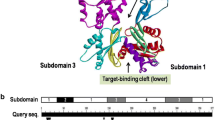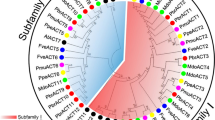Abstract
Plant actins are encoded by complex and highly divergent multigene families. Despite the general lack of intron conservation in animal, fungal and protist actin genes, evidence is presented which indicates that higher plant actin genes have an untranslated leader exon with structural similarity to that found in vertebrate actin genes. All functional higher plant actin genes sequenced to date contain a potential intron acceptor site in the 5′ untranslated region 10 to 13 nucleotides upstream of the initiator ATG. A leader specific cDNA probe hybridized to sequences over 1.0 kbp upstream from the coding region confirming the presence of an upstream exon. Primer extension of mRNA with gene-specific oligonucleotides was used to analyze the 5′ untranslated exon and leader intron from four divergent soybean actin genes, SAc3, 4, 6 and 7. The 5′ ends of all four mRNAs are heterogeneous. The consensus promoter elements of the SAc7 actin promoter were identified. Gene specific primer extension sequencing of actin mRNAs indicated that splicing of the 5′ leader intron occured at the predicted acceptor site in SAc6 and SAc7. The SAc6 and SAc7 5′ untranslated exons are small (88–111 nt) and the leader introns are relatively large (844–1496 nt). The presence of an intron within the 5′ RNA leader and an intron which splits a glycine codon at position 152 in all plant actin genes and all vertebrate muscle actin genes suggests that these structures may have been conserved due to a functional role in actin expression. The 5′ regions of these two soybean actin genes contain many unusual features including (CT) repeats and long stretches of pyrimidine-rich DNA. The possible roles of the upstream exon/intron and the C + T-rich regions are discussed.
Similar content being viewed by others
References
Baird V, Meagher RB: A complex gene family encodes actin in petunia. EMBO J 6: 3223–3231 (1987).
Balcarek JM, McMorris FA: DNase I hypersensitive sites of globin genes of uninduced friend erythroleukemia cells and changes during induction with dimethyl sulfoxide. J Biol Chem 258: 10622–10628 (1983).
Bergsma DJ, Chang KS, Schwartz RJ: Novel chicken actin gene: third cytoplasmic isoform. Mol Cell Biol 5: 1151–1162 (1985).
Bernues J, Beltran R, Casasnovas JM, Azorin F: Structural polymorphism of homopurine-homopyrimidine sequences: the secondary DNA structure adopted by a d(GA.CT)22 sequence in the presence of zinc ions. EMBO J 8: 2087–2094 (1989).
Bornstein P, McKay J, Liska DL, Apone S, Devarayalu S: Interactions between the promoter and first intron are involved in transcriptional control of α1(I) collagen gene expression. Mol Cell Biol 8: 4851–4857 (1988).
Bravo R, Fey SJ, Small JV, Larsen PM, Celis JE: Coexistence of three major isoactins in a single sarcoma 180 cell. Cell 25: 195–202 (1981).
Brinster RL, Allen JM, Behringer RR, Gelinas RE, Palmiter RD: Introns increase transcriptional efficiency in transgenic mice. Proc Natl Acad Sci USA 85: 836–840 (1988).
Brown JW: A Catalogue of splice junction and putative branch point sequences from plant introns. Nucl Acids Res 14: 9549–9559 (1986).
Buchman AR, Berg P: Comparison of Intron-Dependent and intron-independent gene expression. Mol Cell Biol 8: 4395–4405 (1988).
Callis J, Fromm M, Walbot V: Introns increase gene expression in cultured maize cells. Genes and Devel 1: 1183–1200 (1987).
Chouh C-C, Davis RC, Fuller ML, Slovin JP, Wong A, Wright J, Kania S, Shaked R, Gatti RA, Salser WA: g-actin: Unusual mRNA 3′-untranslated sequence conservation and amino acid substitution that may be cancer related. Proc Natl Acad Sci USA 84: 2575–2579 (1987).
Coulombe B, Ponton A, Daigneault L, Williams BRG, Skup D: Presence of transcription regulatory elements within an intron of the virus-inducible murine TIMP gene. Mol Cell Biol 8: 3227–3234 (1988).
DePonti-Zilli L, Seiler-Tuyns A, Paterson BM: A 40-base pair sequence in the 3′ end of the β-actin gene regulates β-actin mRNA transcription during myogenesis. Proc Natl Acad Sci USA 85: 1389–1393 (1988).
Dibb NJ, Newman AJ: Evidence that introns arose at proto-splice sites. EMBO J 8: 2015–2021 (1989).
Eick D, Piehaczyk M, Henglein B, Blanchard J-M, Traub B, Kofler E, Wiest S, Lenoir GM, Bornkamm GW: Aberrant c-myc RNAs of Burkitt's lymphoma cells have longer half-lives. EMBO J 4: 3717–3725 (1985).
Evans MJ, Scarpulla RC: Both upstream and intron elements are required for elevated expression of the rat somatic cytochrome c gene in COS-1 cells. Mol Cell Biol 8: 35–41 (1988).
Frederickson RM, Micheau MR, Iwamoto A, Miyamoto NG: 5′ Flanking and first intron sequence of the human β-actin gene required for efficient promoter activity. Nucl Acids Res 17: 253–270 (1989).
Galson DL, Housman DE: Detection of two tissue-specific DNA-binding proteins with affinity for sites in the mouse β-globin intervening sequence 2. Mol Cell Biol 8: 381–392 (1988).
Gillies SD, Folsom V, Tonegawa S: Cell type-specific enhancer element associated with a mouse MHC gene, E b. Nature 310: 594–597 (1984).
Glikin GC, Gargiulo G, Rena-Descalzi L, Worcel A: Escherichia coli single-strand binding protein stabilizes specific denatured sites in superhelical DNA. Nature 303: 770–774 (1983).
Goodall GJ, Filipwicz W: The AU-rich sequences present in the introns of plant nuclear pre-mRNAs are required for splicing. Cell 58: 473–483 (1989).
Hanley BA, Schuller MA: Plant intron sequences: evidence for distant groups of introns. Nucl Acids Res 16: 7159–7176 (1988).
Hawkins JD: A survey of intron and exon lengths. Nucl Acids Res 16: 9893–9908 (1988).
Heilig R, Muraskowsky R, Mandel J: The ovalbumin gene family. The 5′ end region of the X and Y genes. J Mol Biol 156: 1–19 (1982).
Heller M, Flemington E, Kieff E, Deininger P: Repeat arrays in cellular DNA related to the Epstein-Barr virus IR3 repeat. Mol Cell Biol 5: 457–465 (1985).
Hentschel CC: Homocopolymer sequences in the spacer of a sea urchin histone gene repeat are sensitive to S1 nuclease. Nature 295: 714–714 (1982).
Hightower RC, Meagher RB: Divergence and differential expression of soybean actin genes. EMBO J 4: 1–8 (1985).
Hightower RC, Meagher RB: The molecular evolution of actin. Genetics 114: 315–332 (1986).
Hoffman-Liebermann B, Liebermann D, Troutt A, Kedes LH, Cohen SN: Human homologs of TU transposon sequences: Polupurine/polypyrimidine sequences elements that can alter DNA conformation in vitro and in vivo. Mol Cell Biol 6: 3632–3642 (1986).
Jackson WT: In: Lloyd CW (ed) The Cytoskeleton in Plant Growth and Development, pp, 3–29. Academic Press, New York (1982).
Kamiya N: Physical and chemical basis of cytoplasmic streaming. Annu Rev Plant Physiol 32: 205–236 (1982).
Kawamoto T, Makino K, Niwa H, Sugiyama H, Kimura S, Amemura M, Nakata A, Kakunaga T: Identification of the human β-actin enhancer and its binding factor. Mol Cell Biol 8: 267–272 (1988).
Kozak M: Effects of intercistronic length on the efficiency of reinitiation by eucaryotic ribosomes. Mol Cell Biol 7: 3438–3445 (1987).
Langford CJ, Klinz F-J, Donath C, Gallwitz D: Point mutations identify the conserved intron-contained TACTAAC box as an essential splicing signal sequence in yeast. Cell 36: 645–653 (1984).
Larsen A, Weintraub H: An altered DNA conformation detected by S1 nuclease occurs at specific regions in active chick globin chromatin. Cell 29: 606–622 (1982).
Liebermann D, Hoffman-Liebermann B, Troutt AB, Kedes L, Cohen SN: Sequences from sea urchin TU transposons are conserved among multiple eucaryotic species, including humans. Mol Cell Biol 6: 218–226 (1986).
Lin C-S, Ng S-Y, Gunning P, Kedes L, Leavitt J: Identification and order of sequential mutations in β-actin genes isolated from increasingly tumorigenic human fiberblast strains. Proc Natl Acad Sci USA 82: 6995–6999 (1985).
Mason AJ, Evans BA, Cox DR, Shine J, Richards RI: Structure of mouse kallikrein gene family suggests a role in specific processing of biologically active peptides. Nature 303: 300–307 (1983).
McKnight TD: DNA Sequences at the Five Prime Ends of Plant Genes. PhD Thesis, University of Georgia (1983).
McLean Md, Baird WmV, Gerats AGM, Meagher RB: Determination of copy number, and linkage relationships among five actin gene subfamilies in Petunia hybrida. Plant Mol Biol 11: 663–672 (1988).
Metcalf TN, Szabo LJ, Schubert KR, Wang JL: Ultra-structural and immunochemical analyses of the distribution of microfilaments in seedlings and plants of Glycine max. Protoplasma 120: 91–99 (1984).
Mohun TJ, Taylor MV, Garrett N and Gurdon JB: The CArG promoter sequence is necessary for muscle-specific transcription of the cardiac actin gene in Xenopus embryos. EMBO J 8: 1153–1161 (1989).
Naharro G, Robbins KC, Reddy EP: Gene product of ν-fgr onc: Hybrid protein containing a portion of actin and a tyrosine-specific protein kinase. Science 223: 63–66 (1984).
Nairn CJ, Winesett L, Ferl RJ: Nucleotide sequence of an actin gene from Arabidopsis thaliana. Gene 65: 247–257 (1988).
Nakajima-lijima S, Hamada H, Reddy P, Kakunaga T: Molecular structure of the human β-actin gene: Interspecies homology of sequences in the introns. Proc Natl Acad Sci USA 82: 6133–6137 (1985).
Ng S-Y, Gunning P, Eddy R, Ponte P, Leavitt J, Shows T, and Kedes L: Evolution of the functional human β-actin gene and its multi-pseudogene family: Conservation of noncoding regions and chromosomal dispersions of pseudogenes. Mol Cell Biol 5: 2720–2732 (1985).
Kamoto H, Hiromoi Y, Ishikawa E, Yamada T, Isoda K, Maekawa H, Hotta Y: Molecular characterization of mutant actin genes which induce heat-shock proteins in Drosophila flight muscles. EMBO J 5: 589–596 (1986).
Pesacreta TC, Carley WW, Webb WW, Parthsarathy MV: F-actin in conifer roots. Proc Natl Acad Sci USA 79: 2898–2901 (1982).
Pikielny CW, Teem JL, Rosbash M: Evidence for the biochemical role of an internal sequence in yeast nuclear mRNA introns: Implications for U1 RNA and Metazoan mRNA splicing. Cell 34: 395–403 (1983).
Rabbitts PH, Forster A, Stinson MA, Rabbitts TH: Truncation of exon 1 from the c-myc gene results in prolonged c-myc mRNA stability. EMBO J 4: 3727–3733 (1985).
Reece K, Wu R: Cloning and analysis of actin genes from rice. In Galau G (ed) First Int Cong-Plant Mol Biol p9: OR-01-08 (abstract) (1985).
Richards JE, Gilliam AC, Shen A, Tucker PW, Blattner FR: Unusual sequences in the murine immunoglobulin m-d heavy-chain region. Nature 306: 483–487 (1983).
Ruskin B, Krainer AR, Maniatis T, Green MR: Excision of an intact intron as a novel lariat structure during pre-mRNA splicing in vitro. Cell 38: 317–331 (1984).
Schon E, Evans T, Welsch J, Efstratiadis A: Conformation of promoter DNA: Fine mapping of S1-hypersensitive structures. Cell 35: 837–848 (1983).
Sekiya T, Kuchino Y, Nishimura S: Mammalian tRNA genes: nucleotide sequence of rat genes for tRNAAsp, tRNAGly and tRNAGlu. Nucl Acids Res 9: 2239–2250 (1981).
Shah DM, Hightower RC, Meagher RB: Complete nucleotide sequence of a soybean actin gen. Proc Natl Acad Sci USA 79: 1022–1026 (1982).
Shah DM, Hightower RC, Meagher RB: Genes encoding actin in higher plants: Intron positions are conserved but the encoding actin in higher plants: Intron positions are conserved but the coding sequences are not. J Mol Appl Genet 2: 111–126 (1983).
Slightom JL, Blechl AE, Smithies O: Human fetal G γ- and A γ-globin genes: Complete nucleotide sequences suggest that DNA can be exchanged between these duplicated genes. Cell 21: 627–638 (1980).
Taniguchi S′I, Kawano T, Kakunaga T, Baba T: Differences in expression of a variant actin between low and high metastatic B16 melanoma. J Biol Chem 261: 6100–6106 (1986).
Ueyama H, Hamada H, Battula N, Kakunaga T: Structure of a human smooth muscle actin gene (aortic type) with a unique intron site. Mol Cell Biol 4: 1073–1078 (1984).
Wright S, Rosenthal A, Flavell R, Grosveld F: DNA sequences required for regulated expression of β-globin genes in murine erythroleukemia cells. Cell 38: 265–273 (1984).
Author information
Authors and Affiliations
Rights and permissions
About this article
Cite this article
Pearson, L., Meagher, R.B. Diverse soybean actin transcripts contain a large intron in the 5′ untranslated leader: structural similarity to vertebrate muscle actin genes. Plant Mol Biol 14, 513–526 (1990). https://doi.org/10.1007/BF00027497
Received:
Accepted:
Issue Date:
DOI: https://doi.org/10.1007/BF00027497




